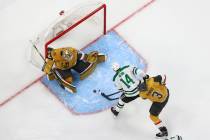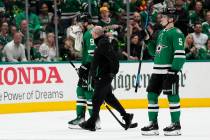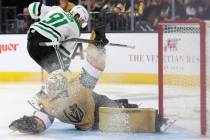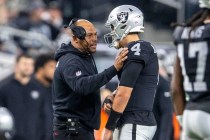Pay-to-play no answer to preps’ fund woes
There are no easy answers. No uncomplicated solution gift-wrapped with a bow.
You can’t dress up a proposed $120 million in school district budget cuts. You can’t make nice the notion of slashing 260 administrative positions or eliminating early retirement incentives or ending block scheduling or any of the other planned ways to answer a looming financial crisis in a state that has underfunded education for years.
But the idea of pay-to-play for high school athletics in Nevada should remain buried deep in a stack of excessive suggestions.
That’s not to say athletics shouldn’t also feel the pain of a guillotine’s blade. It’s just that pay-to-play is the wrong road to venture down.
The harm associated with it, no matter how nominal a fee for participation, far outweighs any benefit.
“The public perception is that when teachers are losing jobs and you still have sports programs, there’s going to be some backlash,” said Eddie Bonine, executive director of the Nevada Interscholastic Activities Association. “Everyone has their opinion and valid points on this. But I’ll tell you — I have attended 11 town hall meetings on the (budget crisis), and not one time did someone who was called to the microphone to discuss cuts mention getting rid of sports or a pay-to-play (theory).
“Athletics is not a sacred cow. We are all educators first. But my hope is that we might have to take away games and cut back schedules and be OK.”
Research shows that of the states where pay-to-play is mandatory, participation rates in athletics often drop considerably, that an average fee of around $300 per child nationally causes many families to pull students from sports, which often leads to those same kids losing their desire to learn and ultimately dropping out. It shows that with fewer bodies competing on the field, grade-point averages slip and discipline problems increase off it.
It shows that when a family is forced to choose between a brother and sister for pay-to-play, it more often selects the male, setting back gender equity advances that need to remain moving forward. It shows a monetary strain on thousands of families already paying taxes for something that should be included at their respective schools.
Another thing: Kids need to be active. Too many exist in a sedentary position. It’s not healthy. We are a nation of teenage couch potatoes clutching video game controllers.
It’s a main point in a study conducted by the Department of Sports Education Leadership at UNLV, which examined the status of physical activity in Nevada public schools, grades K to 12. Its most compelling finding: a lack of opportunity for students.
“I understand there are huge challenges in front of the educational policy makers in our state,” said Monica Lounsbery, chair of the department and one author of the report. “But I’m not sure they always consider all the (health) ramifications on students that come with some of those decisions to cut back or not offer as many (physical education) opportunities.”
Said Nancy Lough, another member of the department: “These are tough times. It’s a dilemma. I imagine it’s a very compromising time for (high school) athletics given the economy.
“But the truth of the matter is, parents are already paying for sports in some regard. In some cases, a lot.”
In Nevada, they pay around $100 for football cleats and $65 more for spirit shorts and T-shirts and even more for food at away games. Some can afford it; many can’t. Booster clubs help, but often the money they raise must go to a general fund and not be allocated to specific sports.
Consider these options: Reduce schedules. Propose another round of realignment to save on transportation. Go to three divisions across the state instead of four in all sports but football. Limit tournament play to a 150-mile radius from city limits. Have teams from multiple schools travel on one bus. Cut the number of officials in football and basketball.
These all are ways NIAA officials are considering to save money, to keep from asking parents to write a check for their children to play sports.
The guillotine should fall on athletics as it will other areas of high school life when budgets are slashed in Nevada. But not in a pay-to-play manner. Not down that road.
“We are not the only state going through this,” Bonine said. “There are states in far worse shape than us. Does my gut say (Nevada) will find the money? I don’t think so. Will we have to adjust (in athletics)? Absolutely.
“But I’ll do everything I can to keep teams playing as many games as possible and as much going on with athletics as possible. The kids need it.”
It’s like everything with major budget cuts. There are no easy answers.
Just brutally tough decisions.
Las Vegas Review-Journal columnist Ed Graney can be reached at 702-383-4618 or egraney@reviewjournal.com.


















